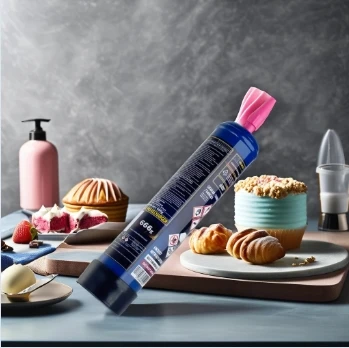
Avoid disappointment over your desserts! It’s time to reveal the secrets of the professionals and how your whipped cream could be a match for the velvety, whipped cream, foams and espumas that are severed in Michelin star restaurants. Whats the secret? is simple: it’s all in the cream charger. Your cream charger determines the taste, texture and longevity of your whipped cream, so making sure it’s of the highest quality is essential. You may already know of Mosa, Liss and QuickWhip, proud architects of cream chargers and our preferred manufacturers. With their help, we guarantee whipped cream like no other, whether you opt for our classic HappyWhip cream chargers, or choose our very own brand, HappyWhip. Since we only accept the best, our own branded Chargers contain exactly 8.2g of the same superior food grade N2O, free of oil and impurities. The key difference between the chargers is HappyWhip’s luxury shiny silver coating. So how do these cream canisters bring your whipped cream to delicious perfection? By combining a cream charger with a whipped cream dispenser, adding powdered sugar to taste, it takes just a matter of minutes for the transformation to take place. Just follow these easy steps: Remove the head of your dispenser, pour in the whipping cream appropriate to its size, along with sweetener or powdered sugar to your taste, and replace head. Locate and unscrew the cartridge holder. Slot in your chosen cream charger, round end first, allowing the charger’s tip to be punctured as you screw the holder back on. Shake the dispenser 3 times, enabling the N2O to filter through the mixture. Do not over-shake. Turn the dispenser upside down and squeeze the handle to effortlessly bring your whipped cream dreams to life! Not only does this process produce professional quality whipped cream, but it also creates a great deal more of it than usual. For example, with the trusty help of a dispenser, you can turn half a litres cream into a remarkable 1.5 litres of whipped cream, three times the volume! Not only that, but as long as you keep your dispenser in the fridge, you can enjoy delicious, fresh whipped cream for up to 14 days, at the touch of a button. Dessert making has never been so easy! Whether you’re looking for whipped cream excellence in your restaurant, cafe or at home, or even as a gift for a friend, don’t settle for other mediocre cream charger brands. Trust in our expertise at HappyWhip to deliver consistent professional high-quality results, every time, without the high price tag. And the most delicious part? We offer the lowest prices in the United States of America with a price match guarantee, so rest assured that we’ve got your whipped cream needs covered. Now, what will you cover with your whipped cream?
